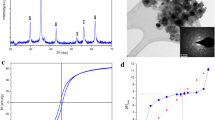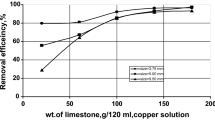Abstract
The sorption of inorganic lead(II) on two cationic resins containing different complexing groups, the iminodiacetic Chelex 100 and the carboxylic Amberlite CG-50, was investigated. The Gibbs-Donnan model was used to describe and predict the sorption through the determination of the intrinsic complexation constants. These quantities, even though non-thermodynamic, characterize the sorption as being independent of experimental conditions. The sorption mechanism for metals on complexing resins was also studied by adding a competitive soluble ligand that shifts the sorption curves to higher pH. The ligand competes with the resin for complexation with the metal ion. Lead(II) is strongly sorbed on Chelex 100 through the formation of two complexes in the resin phase: MHL with log 10 β 111i =−0.3 and ML with log 10 β 111i =−3.7. The presence of the competitive ligand in solution allows for the determination of a third complex. Furthermore, on Amberlite CG-50 the sorption is rather strong and involves the formation of the complex ML, in more acidic solution, with log 10 β 110i =−2.0. In the presence of the ligand PyDA, the ML(OH) complex was characterized by log 10 β 11−1i =−5.6. In all the experiments the hydrolysis reactions in the aqueous phase are considered quantitatively.
Similar content being viewed by others
References
Merle, Y., Marinsky, J.: Gel speciation studies I—The intrinsic dissociation constant of weakly acidic cation-exchange gels. Talanta 31, 199–204 (1984)
Szabadka, Ö: Studies on chelating resins I—General equation for the calculation of the protonation constants of chelating resins. Talanta 29, 179–181 (1982)
Högfeldt, E., Miyajima, T., Muhammed, M.: On protonation equilibria of Sephadex C-25 and C-50. Talanta 36, 409–412 (1989)
Högfeldt, E., Szabadka, Ö., Marton, A., Varga, E.: Description of the protonation equilibria of complex forming resins by the Donnan and by the site interaction models: A comparison of the calculation methods. React. Funct. Polym. 38, 113–126 (1998)
Biesuz, R., Zagorodni, A., Muhammed, M.: Estimation of deprotonation coefficients for chelating ion exchange resins. Comparison of different thermodynamic model. J. Phys. Chem. B 105, 4751–4726 (2001)
Stohr, C., Horst, J., Holl, W.H.: Application of the surface complex formation model to ion exchange equilibria Part V. Adsorption of heavy metal salts onto weakly basic anion exchangers. React. Funct. Polym. 49, 117–132 (2001)
Ferreira, L.M., Loureiro, J.M., Rodrigues, A.E.: Sorption of metals by an amidoxime chelating resin. Part I: equilibrium. Sep. Sci. Technol. 33, 1585–1604 (1998)
Szabadka, Ö., Varga, E., Nagy, L.: Determination of protonation- and metal complex stability constants for a chelating monomer and its immobilized in polymer resin. Talanta 59, 1081–1088 (2003)
Pesavento, M., Biesuz, R.: Characterisation and application of chelating resins as chemical reagents for metal ions, based on Gibbs-Donnan model. React. Funct. Polym. 36, 135–147 (1998)
Biesuz, R., Pesavento, M., Alberti, G., Dalla Riva, F.: Investigation of sorption equilibria of Mn(II), Cu(II) and Cd(II) on a carboxylic resin by the Gibbs-Donnan model. Talanta 55, 541–550 (2001)
Pesavento, M., Biesuz, R., Baffi, F., Gnecco, C.: Determination of metal ions concentration and speciation in seawater by titration with an iminodiacetic resin. Anal. Chim. Acta 401, 265–276 (1999)
Helfferich, F.: Ion Exchange. McGraw-Hill, New York (1962)
Ringbon, A., Still, E.: The calculation and use of α coefficients. Anal. Chim. Acta 59, 143–146 (1972)
Pesavento, M., Biesuz, R., Alberti, G., Dalla Riva, F.: Evaluation of the sorption of metal ions on a complexing resin in contact with different solutions based on the Gibbs Donnan model. React. Funct. Polym. 46/3, 233–246 (2001)
Academic Software: IUPAC Stability Constants Database (scdbase@acadsoft.co.uk) (2001)
Puigdomenech, I.: MEDUSA: Make Equilibrium Diagram using Sophisticated Algorithms. Windows program, Stockholm, Version 21, Aug. 2001
Botta, D., Mantica, E.: Micropollutants migration from ion-exchange resins into water. Water Res. 33, 1054–1064 (1999)
Baffi, F., Cardinale, A.M., Buzzone, R.: Preconcentration of chromium, copper and manganese from sea water on pretreated solid materials for determination by atomic absorption spectroscopy. Anal. Chim. Acta 270, 79–86 (1992)
Napoli, A.: Lead(II) complexes of some N-substituted iminodiacetic acid. J. Coord. Chem. 14, 127–131 (1985)
Vetere, V.F., Romagnoli, R.: Study of complexation equilibria using polarized metallic electrodes. Analyst 116, 937–940 (1991)
Author information
Authors and Affiliations
Corresponding author
Rights and permissions
About this article
Cite this article
Biesuz, R., Alberti, G. & Pesavento, M. Sorption of Lead(II) on Two Chelating Resins: From the Exchange Coefficient to the Intrinsic Complexation Constant. J Solution Chem 37, 527–541 (2008). https://doi.org/10.1007/s10953-008-9254-6
Received:
Accepted:
Published:
Issue Date:
DOI: https://doi.org/10.1007/s10953-008-9254-6




